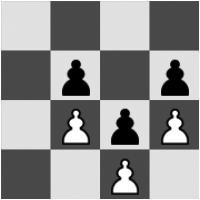
Space in the Endgame, Part 2
In the first part of this short series we saw some examples of the advantage that extra space confers on its owner. Now we will see the dark side of the space advantage - the weaknesses left behind as your forces advance further across the board. As an example, let's look at the following two positions:
Both of these are quite simple positions. You could say that White has a space advantage in both, due to his advanced pawns. But in the first one he is immediately winning (1.g6 fxg6 2.h6 or 1...hxg6 2.f6 etc), while in the second, where it even looks like he has more of a space advantage, he is completely lost, since the black king will succeed in coming over to take his pawns!
What is the difference? Well, in the first White's pawns are mobile, and this allows him to make use of them. In the second, the advanced pawns are completely useless, and White loses because he cannot defend the space behind them. If they were securely at home at h2, g2, and f2, then he would not lose.
Whenever a pawn advances it leaves weaknesses behind. This is the dark side of a far-advanced structure. When fighting against an opponent's advantage in space, you need to use a strategy of "pinpricks" - attack various weaknesses, increase the activity of your pieces, and undermine the foundations of your opponent's position. When these things are not possible, you need to play solidly and await your chance, as in the following example by Mikhail Tal:

In the Grünfeld defense, there are many variations where White is able to obtain a strong pawn center and more-advanced pawns. Additionally, there are many lines involving an early queen-trade by ...Qa5+xd2. Thus, an interesting and complex queenless middlegame often arises, in which White has an advantage in space while Black has pressure on White's often over-extended structure. The following is a typical example, in which Black sends his knight on a long maneuver to invade the base of White's structure:
The concept of space in a chess position is not so simple as the pawn structure. In the first two positions of this article, who really has a space advantage? White with the advanced pawns, or Black with the advanced king position?
In the first position, the far-advanced pawns proved to be critical, while in the second it was Black's space advantage which won. In the Giri game, White has the more advanced structure at the start, but soon it turns out that in spite of this his pieces don't have enough room in his own camp.
Thus a space advantage must involve both the pieces and pawns, and simply means that you control more squares than your opponent. To fight this, you need to make your own pieces as active as possible, to destroy your opponent's structure and open lines and diagonals for your own pieces.
RELATED STUDY MATERIAL
- Read Part 1 of this series;
- Watch IM Steven Zierk's Pawn Endgames 4 video which includes the theme of creating a passed pawn;
- Watch GM Dejan Bojkov's Greatest Chess Minds Part 2 and Part 4 on space in the endgame;
- Explore the Gruenfeld Defense, Modern Exchange Variation.






